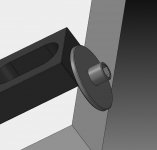Machinerer
Cast Iron
- Joined
- Jun 12, 2009
- Location
- Clearwater, FL
Seems pretty simple, but I have a large hogout, aluminum, 26.5"x15.5"x6.5". It's about 200lbs. For the very first operation, the operator is hand drilling/tapping 5 holes in the part, and I'm trying to take some work off of the operator, and he is already very busy running multiple machines. This fixture was originally designed using the clamps you see in the screenshot(Carr-Lane CL-15-SAC) however from the way they feel, I have about zero confidence in these clamps, especially considering this part is being roughed very aggressively in an HMC, so I'd hate to see 200lbs of aluminum fall on spindle moving 300ipm. I ended up putting 4 holes in void areas of the part, which I put 1/2-13 studs in, and thru bolt them through the fixture. Good thing I did, because after roughing the first part, all of those clamps had vibrated loose. My question, is does anyone have suggestions of a better way to hold this part, that would give me a little more confidence, and take the hand drilling off of the operator?
The part cannot stick off the tombstone any more than it already does, whatever workholding is used cannot be any higher than an inch along the outside perimeter. I appreciate any suggestions!!


The part cannot stick off the tombstone any more than it already does, whatever workholding is used cannot be any higher than an inch along the outside perimeter. I appreciate any suggestions!!




